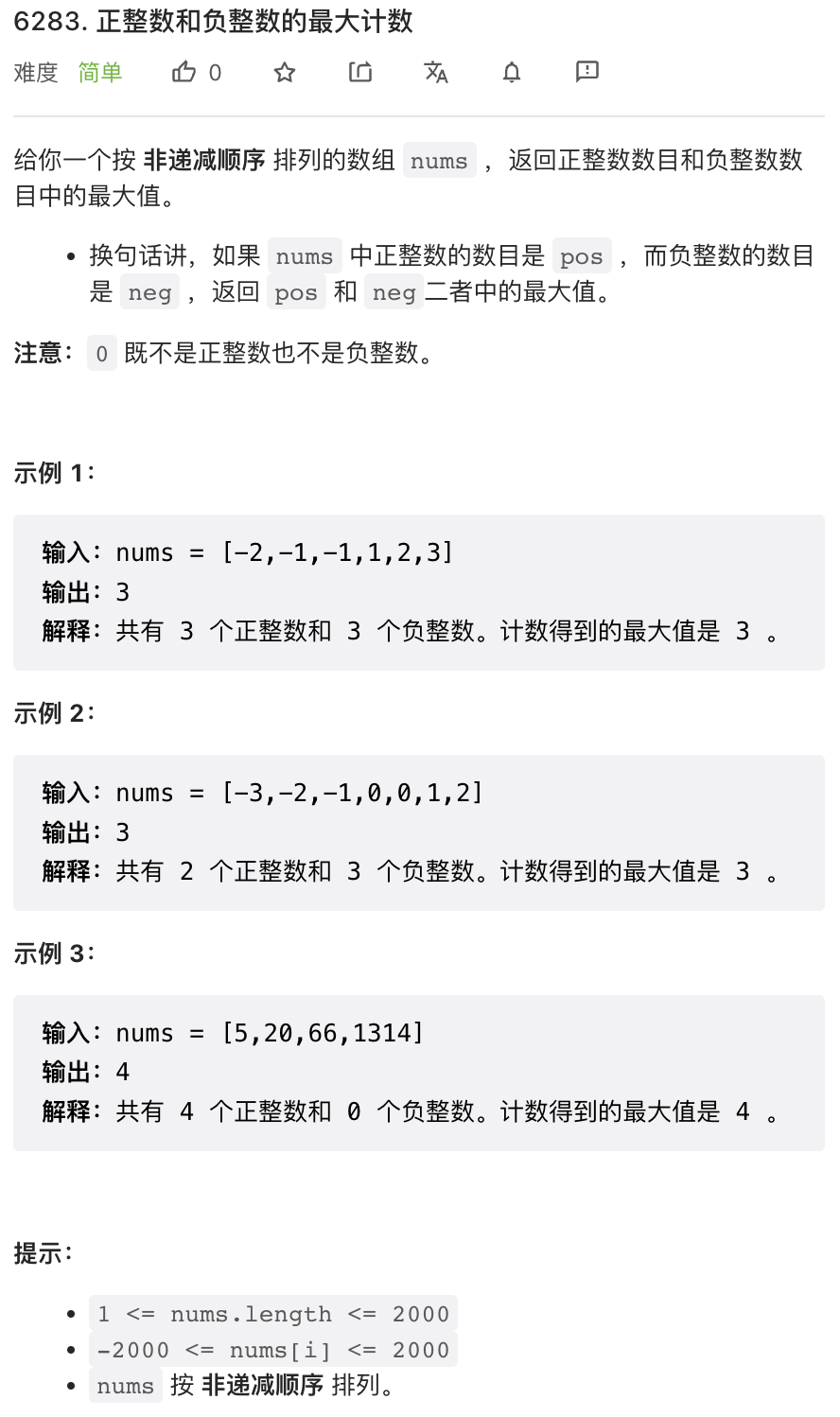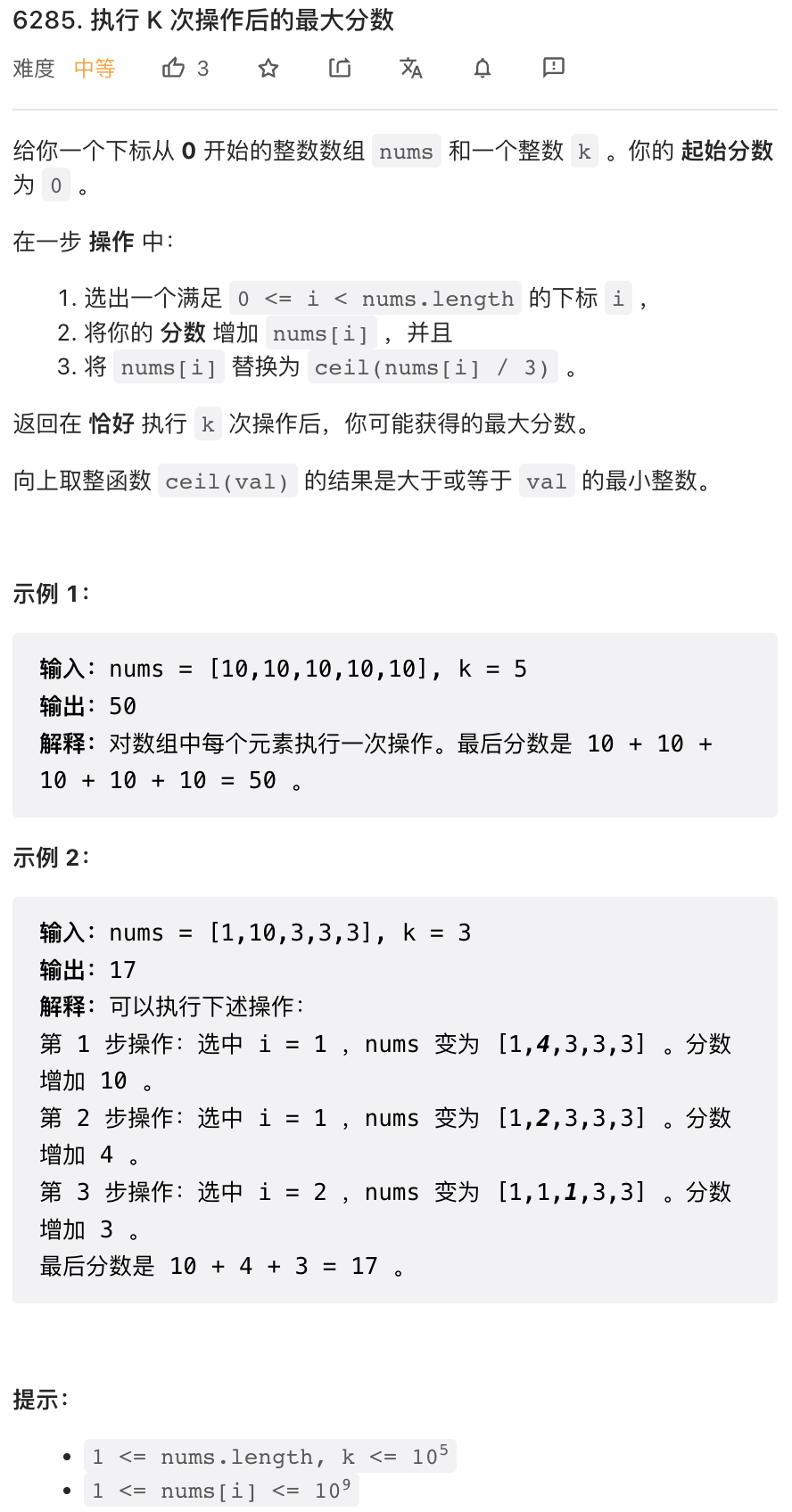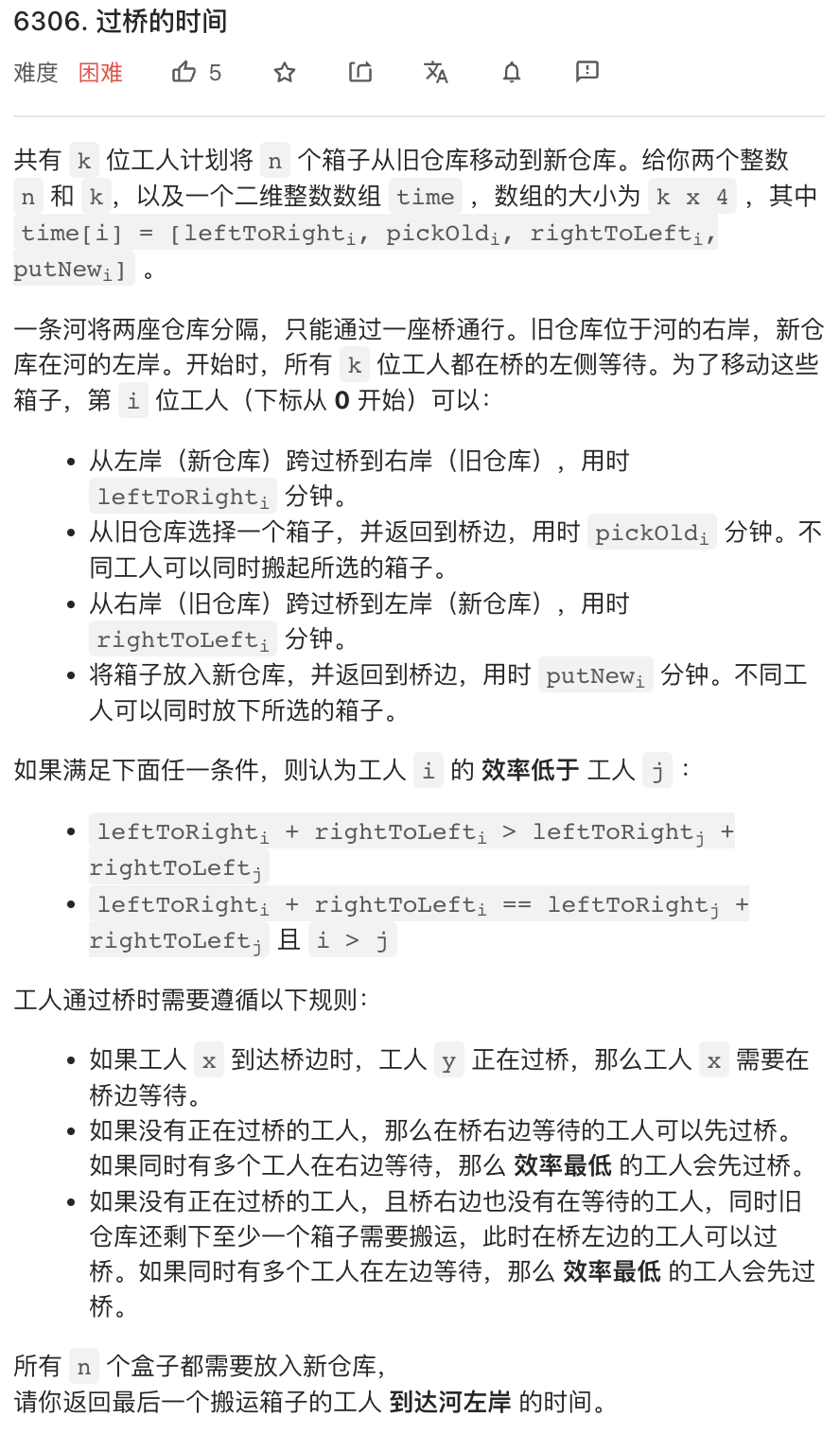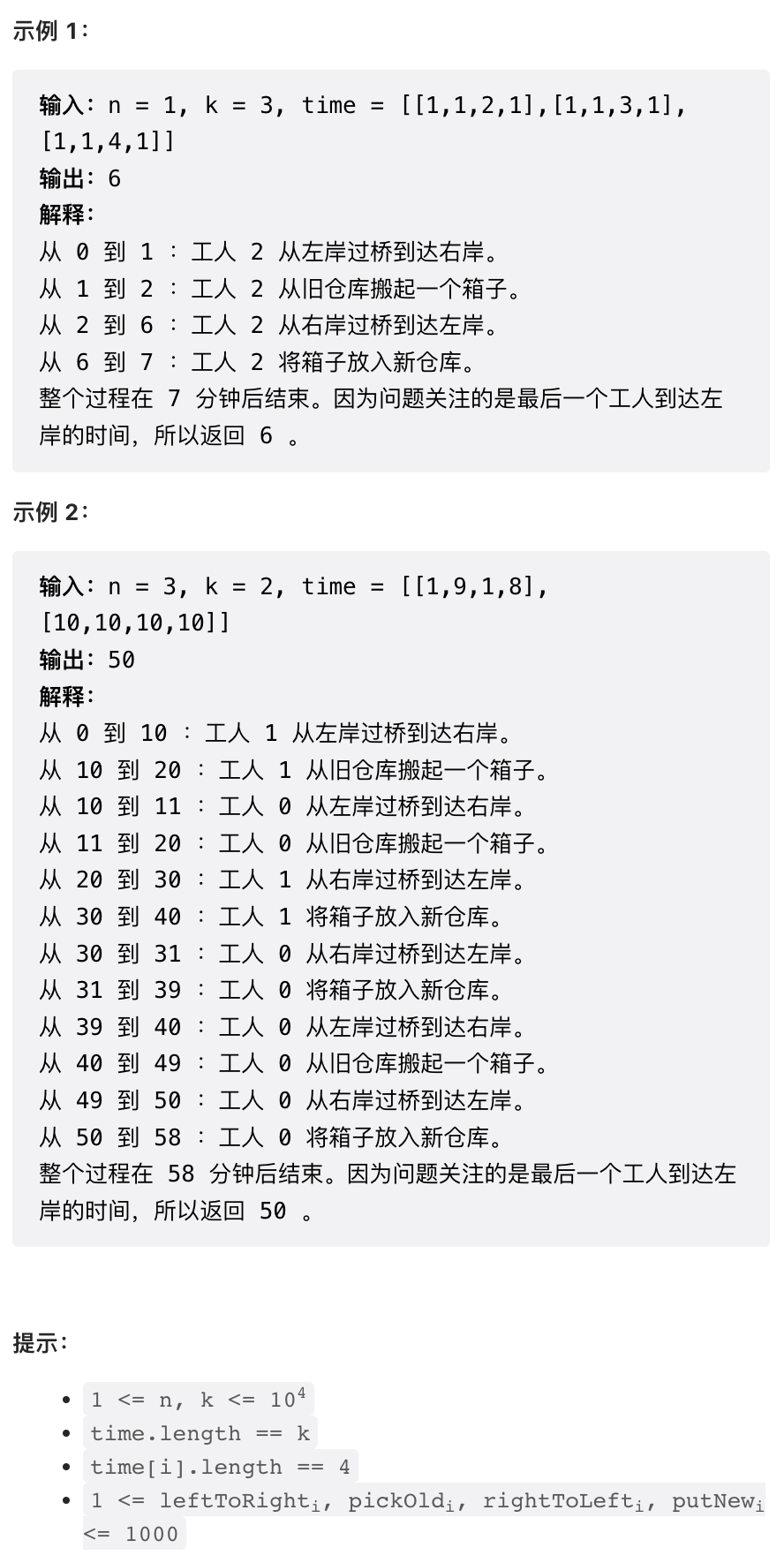本周周赛跟优先队列过不去,第二题、第四题总共使用了 5 个优先队列。。
1.

按题述要求实现即可。
class Solution:
def maximumCount(self, nums: List[int]) -> int:
return max(sum(1 for x in nums if x > 0), sum(1 for x in nums if x < 0))
2.

这个题目可以使用优先队列模拟。每次操作时从优先队列取出最大元素,操作之后将 x / 3 放回优先队列即可。
练习一下 Python 优先队列 API.
class Solution:
def maxKelements(self, nums: List[int], k: int) -> int:
nums = [-x for x in nums]
heapify(nums)
res = 0
while k:
k -= 1
res += -nums[0]
heappushpop(nums, nums[0] // 3)
return res
3.

本题应该有很多种不同的解法。这里的解法的思路是,一次操作无非是交换了两个字母,我们可以先统计 word1, word2 中不同字母的数量,然后枚举被交换的字母(共有 26 * 26 种情况需要枚举),每种情况检查不同字母数量是否相等即可。
class Solution:
def isItPossible(self, word1: str, word2: str) -> bool:
N = 26
# 字母计数
c1, c2 = [0] * N, [0] * N
bias = ord('a')
for c in word1:
c1[ord(c) - bias] += 1
for c in word2:
c2[ord(c) - bias] += 1
# 不同字母个数
d1 = sum(1 for x in c1 if x != 0)
d2 = sum(1 for x in c2 if x != 0)
# 尝试交换 word1 中字母 i 与 word2 中字母 j
for i in range(N):
# 如果 word1 不含 i 则跳过
if c1[i] == 0:
continue
for j in range(N):
# 如果 word2 不含 j 则跳过
if c2[j] == 0:
continue
if i != j:
# 如果 i, j 不想等,则 word1 失去一个 i, word2 失去一个 j
# 推算交换后的不同字母个数
_d1 = d1 + (c1[j] == 0) - (c1[i] == 1)
_d2 = d2 + (c2[i] == 0) - (c2[j] == 1)
if _d1 == _d2:
return True
elif d1 == d2:
# 如果 i, j 相等,d1, d2 不变
return True
# 没有搜索到合理解
return False
4.


这道题目其实不是很难,因为暴力模拟就可以了。但比较麻烦。
在暴力模拟思路就是枚举每个「关键时刻」的行动。每个时刻,有这样几个关键点需要处理:
- 左右两岸等待的工人,按照题述逻辑决定某个工人过桥,可以左右分别使用一个优先队列决定过桥顺序
- 正在 pick or put 的工人,如果完成工作则加入等待序列,可以分别使用一个优先队列来选取完成工作的工人
于是,总计需要使用四个优先队列。
这种题目思路上不难,难点在于设计一个比较简洁的实现,并保证没有 BUG 实现出来。
class Solution {
public:
int findCrossingTime(int n, int k, vector<vector<int>>& time) {
// 左右两岸等待的工人,pair 两个元素分别是 efficiency 和 工人 id
priority_queue<pair<int, int>> left, right; // worker <eff, id>
// 正在 pick & put 的工人,pair 第一个元素工作完成的时间取负 -time
// 负号是因为 C++ 优先队列是逆序排序
priority_queue<pair<int, int>> pick, put; // worker <-time, id>
// 计算 efficiency 并将所有工人加入左岸等待队列
vector<int> eff(k);
for(int i = 0; i < k; i++) {
eff[i] = time[i][0] + time[i][2];
left.push({eff[i], i});
}
// last: 最后一个工人回到左岸时刻
// curr: 当前时刻
// 由于桥只能有一个工人走,所以重点考察桥上的逻辑
int last = 0, curr = 0;
// 还有剩余货物或者还有工人没有回来
while(n > 0 or right.size() or pick.size()) {
// 完成 pick 的工人
while(pick.size() and -pick.top().first <= curr) {
int w = pick.top().second;
pick.pop();
right.push({eff[w], w});
}
// 完成 put 的工人
while(put.size() and -put.top().first <= curr) {
int w = put.top().second;
put.pop();
left.push({eff[w], w});
}
// 过桥逻辑
// 按照题述,先处理右岸等待
if(right.size()) {
int w = right.top().second;
right.pop();
// 开始过桥之后,直到完成 pick 都不会再等待
// 过桥后再次进入等待的时刻
int _nt = -curr - time[w][2] - time[w][3];
// 直接加入 put 队列等待
put.push({_nt, w});
last = max(last, curr + time[w][2]);
curr += time[w][2]; // 占用桥 time[w][2] 时间
} else if(left.size()) {
int w = left.top().second;
left.pop();
// 仅当还有剩余货物时,再次出发
if(n) {
n--;
// 与右侧逻辑类似
int _nt = -curr - time[w][0] - time[w][1];
pick.push({_nt, w});
curr += time[w][0];
}
} else {
// 如果两侧都没有人在等待,则检查一下正在 pick & put 的工人
// 将最近一个工人完成工作的时间点设置为 curr
int t1 = pick.size() ? -pick.top().first : INT_MAX;
int t2 = put.size() ? -put.top().first : INT_MAX;
curr = min(t1, t2);
}
}
return last;
}
};